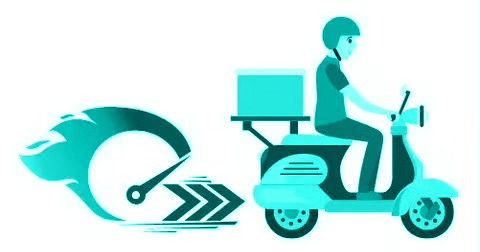If necessity is the mother of invention, urgency is the uncle of change!
Quick commerce an evolving landscape. Despite having a limited assortment and SKUs compared to other formats, q-commerce companies like Instamart, Blinkit, and Zepto have grown tremendously. So, what is it that is working in their favour? It's the immediacy of quick commerce delivery that is shifting consumer preferences.
Kailash Rathod, Co-Founder Valuecom.in
10/1/20246 min read


Ankita Jadhav, an engineer and mother of two, halfway through packing the tiffin for her children for school realized she had no bread for the sandwich. In the past, she would have called her local grocery store next to her society building in Navi Mumbai and had the item delivered in about 30 minutes to two hours. But instead, she used Instamart, an ‘instant’ delivery app, and the bread was at her door in nine minutes. Welcome to the world of “Quick Commerce”, a new business model to serve different consumer needs.
Quick commerce (q-commerce) is a type of e-commerce that delivers products and services to customers in minutes rather than days. It's characterized by speed and is often used for small orders, such as groceries, office supplies, gifts, or other daily essentials.
You would have heard many stories about how instantly someone got the deliveries of electronics like a laptop in just 8 minutes and the recent stories of offering a 10-minute delivery of the iPhone 16.
Quick commerce is altering India's retail landscape and posing a direct challenge to e-commerce giants like Amazon, Flipkart, and millions of traditional neighborhood 'Kirana' stores.
Before understanding the forces driving quick commerce, understand retailing and get a glimpse of the phases under which it has undergone a significant transformation.
Consumers buying goods and services from businesses or individuals fall under the retail economy.
Traditional Neighborhood Stores: For several centuries people shopped in open-air markets and weekly haats evolving to more than 13 million neighborhood grocery outlets.
Organized Retail: The initial movement of modern retailing was started by a few fashion brands like Raymond, Bombay Dyeing, Bata, the government, and various co-operatives. The first inflection point came when Shoppers Stop became successful in running world-class modern stores and the success of Kishor Biyani in setting up Pantaloons and Big Bazaar. Sensing the big opportunity, large corporates such as Tata, Reliance, Aditya Birla, Mahindra & Mahindra entered this sector. After the FDI policy of 2005-2006, several international brands also entered the market through joint ventures. Now, India has a shopping mall culture across various towns, thanks to the changing consumption preferences of affluent audiences.
E-commerce: The Internet was launched in India in 1995 through dial-up in 6 cities. Increasing penetration of mobile phones has played a key role in the evolution of the internet and subsequently e-commerce in India. Early trends were started by online services like railway ticket bookings, job hunting, and matrimony. However, the real push came in 2007 when Flipkart was launched by two ex-Amazon employees. The entry of global leader Amazon in Jun 2013 marked the emergence of e-commerce in India.
An evolving landscape:
The concept of instant deliveries has expanded beyond restaurant foods to daily essentials like groceries, personal care, home care, cosmetics, and medicines, and now it is moving beyond daily essentials like electronics and others, combining the experience of instant gratification with the convenience of home shopping.
As per IBEF, in 2023 the e-commerce market is estimated to be valued between US$ 57-60 billion and quick commerce US$ 2.3 If quick commerce is just 4% of total online retail, then why are e-commerce incumbents worried about it? It's the rate at which quick commerce is growing, a robust estimated compound annual growth rate (CAGR) of 27.9% between FY22 and FY27.
A gigantic 946 million broadband internet subscribers in India, the second highest in the world after China, makes it one of the hottest destinations for the e-commerce market.
On average the total number of SKUs available at a Kirana store - 1,000, Supermarket - 20,000, Hypermarket - 80,000, E-commerce - 150 million, and Q-commerce - 20,000. Bigger retail giants like D-Mart and Jio-Mart have been trying to home-deliver groceries for the last 7-8 years with limited success.
Despite having a limited assortment and SKUs compared to other formats, q-commerce companies like Instamart, Blinkit, and Zepto have grown tremendously. So, what is it that is working in their favour? It's the immediacy of quick commerce delivery that is shifting consumer preferences. Blinkit is doing wonders in its new avatar compared to the earlier Grofer avatar because it adopted the strategy of instant delivery pioneered by Instamart. BigBasket is following the same with their new BB Now avatar.
The companies who have mastered ultra-fast deliveries are winning the market.
Let's understand how Q-commerce companies work:
Order is received on the App
Order gets assigned to the nearest dark store (Dark store - a mini-warehouse for faster delivery in a 2-3 km radius from the customer)
Products are packed in under 2 minutes through smart pick-path optimization in dark stores, at the same time a delivery boy is at the dark store ready to pick it up.
The delivery boy with the help of an optimized route delivers the order within 15 minutes
Inventory gets replenished in dark stores from the warehouse based on demand prediction
Blinkit, Instamart, and Zepto have mastered the quick commerce model like no one. Their success is lies in managing the following 3 key resources very well
FOS (Feet on street delivery person)
Dark Stores
Technology
Instamart and Blinkit are leveraging their parent organizations Swigy and Zomato respectively in managing FOS and Zepto has been very nimble in understanding the role of a delivery person without any previous learning curve.
Be it real-time demand sensing, route optimization, smart-pick path optimization or automation and robotics to enhance the speed and accuracy of warehouse operations, these 3 companies are using technology to the fullest to deliver their promise of ultra-fast deliveries.
These 3 organizations, after mastering the business model with the help of technology and a robust process, arranged for funding to scale up their business. One of the key factors in scaling up is the selection of geography and scaling operations in selected cities with the help of setting up dark stores. As on June 2024, Blinkit has the highest 639 and Instamart has 557 dark stores. It is estimated that Zepto has about 400 dark stores and BB Now from Tata is catching up fast with black stores between 400-500.
Factors driving the growth of the quick commerce market in India
Changing consumer expectations for shopping: Are the consumers looking only for convenience or they are time-starved like Ankita Jadhav? Quick commerce marketers understand the consumer's pulse. They know how to create a unique experience by promising and fulfilling expectations of ultra-fast deliveries. This must be one of the main reasons consumers prefer quick commerce companies.
Assortments besides groceries like fruits, vegetables, meat, FMCG, medicines, cosmetics, and electronics have given consumers wider choice for the convenience of home shopping.
Reliability on peak demand days like events and festivals for delivering gifts or essential items. All quick commerce companies run well-planned promotional events to fulfill the increased demands during festivals like Raksha Bandhan, Diwali, New Year, Valentine's Day, and Cricket matches.
Instant gratification culture in urban areas has boosted the demand for fast-delivery services
Like e-commerce, technology is the backbone of ultra-fast deliveries and unique customer experiences. Technology is helping not just in understanding user behavior and inventory management; it also helps in optimizing the routes for shorter delivery time and in automation of warehouses to enhance the speed and accuracy of operations.
Who will blink first?
Quick commerce is emulating the role of neighborhood 'Kirana' stores with a priority on shorter delivery times.
There is a raging battle between incumbent retailers and tech giants to enter the quick-commerce space. Flipkart recently entered with its 'Minutes' service and Amazon is preparing to launch its quick commerce business in the first quarter of 2025.
While e-commerce giants Amazon and Flipkart still dominate in terms of assortments, SKUs, pricing, and offers, the immediacy of quick commerce delivery could shift consumer preferences, especially for time-starved and convenience-seeking consumers.
The low margins on daily essentials and high operational costs are two big hurdles quick commerce companies have to pass. The market is becoming crowded, leading to aggressive pricing and promotions, making it difficult for quick commerce companies. Quick commerce is a vibrant and rapidly evolving space, it has attracted both domestic and international investors. Indian retail market of about 1 trillion USD is attracting these investors and quick commerce companies are scaling their operations to grab this opportunity. However, after a few years, it will be interesting to see how these quick commerce companies will respond to the pressure of profitability, monetization, and delivering sustainable growth.
The ultimate winner will be the one who delivers the unique customer experiences of ultra-fast deliveries along with a larger assortment of categories with millions of SKUs at the price and offers currently prevailing on the e-commerce market resulting in greater convenience for customers across categories.
Contact us
Whether you have a request, a query, or want to work with us, use the form below to get in touch with our team.


Location
Rayat Innovation Centre Sector 11, Kharghar, Navi Mumbai Maharashtra - 410210, INDIA
Hours
Mon-Fri 9:00-18:00
Sat-Sun Closed
